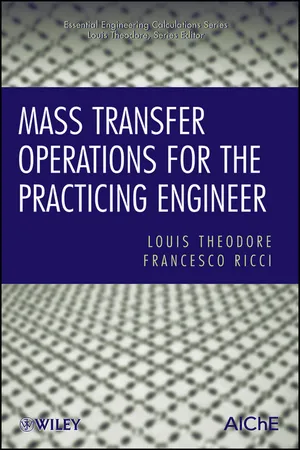![]()
Part One
Introduction
The purpose of this Part can be found in its title. The book itself offers the reader the fundamentals of mass transfer operations with appropriate practical applications, and serves as an introduction to the specialized and more sophisticated texts in this area. The reader should realize that the contents are geared towards practitioners in this field, as well as students of science and engineering, not chemical engineers per se. Simply put, topics of interest to all practicing engineers have been included. Finally, it should also be noted that the microscopic approach of mass transfer operations is not treated in any required undergraduate Manhattan College offering. The Manhattan approach is to place more emphasis on real-world and design applications. However, microscopic approach material is available in the literature, as noted in the ensuing chapters. The decision on whether to include the material presented ultimately depends on the reader and/or the approach and mentality of both the instructor and the institution.
A general discussion of the philosophy and the contents of this introductory section follows.
Since the chapters in this Part provide an introduction and overview of mass transfer operations, there is some duplication due to the nature of the overlapping nature of overview/introductory material, particularly those dealing with principles. Part One chapter contents include:
1 History of Chemical Engineering and Mass Transfer Operations
2 Transport Phenomena vs Unit Operations Approach
3 Basic Calculations
4 Process Variables
5 Equilibrium vs Rate Considerations
6 Phase Equilibrium Principles
7 Rate Principles
Topics covered in the first two introductory chapters include a history of chemical engineering and mass transfer operations, and a discussion of transport phenomena vs unit operations. The remaining chapters are concerned with introductory engineering principles. The next Part is concerned with describing and designing the various mass transfer unit operations and equipment.
![]()
Chapter 1
History of Chemical Engineering and Mass Transfer Operations
A discussion on the field of chemical engineering is warranted before proceeding to some specific details regarding mass transfer operations (MTO) and the contents of this first chapter. A reasonable question to ask is: What is Chemical Engineering? An outdated, but once official definition provided by the American Institute of Chemical Engineers is:
Chemical Engineering is that branch of engineering concerned with the development and application of manufacturing processes in which chemical or certain physical changes are involved. These processes may usually be resolved into a coordinated series of unit physical “operations” (hence part of the name of the chapter and book) and chemical processes. The work of the chemical engineer is concerned primarily with the design, construction, and operation of equipment and plants in which these unit operations and processes are applied. Chemistry, physics, and mathematics are the underlying sciences of chemical engineering, and economics is its guide in practice.
The above definition was appropriate up until a few decades ago when the profession branched out from the chemical industry. Today, that definition has changed. Although it is still based on chemical fundamentals and physical principles, these principles have been de-emphasized in order to allow for the expansion of the profession to other areas (biotechnology, semiconductors, fuel cells, environment, etc.). These areas include environmental management, health and safety, computer applications, and economics and finance. This has led to many new definitions of chemical engineering, several of which are either too specific or too vague. A definition proposed here is simply that “Chemical Engineers solve problems”. Mass transfer is the one subject area that somewhat uniquely falls in the domain of the chemical engineer. It is often presented after fluid flow(1) and heat trans...
